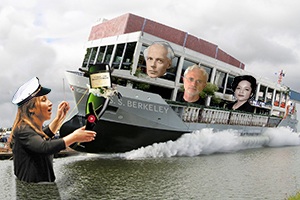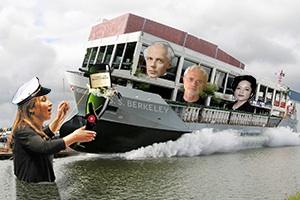
After a strong welcoming ovation, Carneiro responded with “My soul is filled with happiness and gratitude,” before saying a few words about the opening number, Adams’ Chairman Dances. As with most conductors who speak to audiences today, her remarks sounded scarcely prepared and unrehearsed, despite their warm affect, and duplicated the program notes. But when she got down to the main focus of her profession, her technique was impressive.
The Dances were written in 1985 as Adams’ first thoughts on his 1987 opera Nixon in China,, a scene in Act 3 during which Chairman Mao dances a fox-trot with his notorious wife. Adams’ music at this stage in his career was more minimalist than postminimalist. Thus, the music may have sounded overextended and repetitive to those not fond of the style. On the other hand, there are many subtle changes to be heard, especially in the more-dreamy middle section. Carneiro did a fine job delineating varietal elements with her facial expressions and a range of cuing gestures. Also, her wrenching method of marking time to the music at the outset heightened the most memorable aspect of the composition — its driving force. When Adams emerged to acknowledge audience applause at the conclusion, Carneiro gave him (“Someone I consider a mentor”) a big hug.
Some “Lark” and a Bug
Next on the program was Peregrinos by the Symphony’s creative advisor, Gabriela Lena Frank. It’s a set of five fantasies on testimonials she recorded from Latino immigrants in Indianapolis. The first and last contain the same material, most memorably a pentatonic melody played by a solo violin much in the manner of Ralph Vaughan Williams’ The Lark Ascending. The wistfulness of the music reflected the hopes of the immigrants, who at a social center wrote them on ribbons attached to a laundry clothes-rack called a “dream tree.” The middle movements reflect the heroic spirits of two brothers; a scary vision of one smuggled immigrant who emerged from a trunk in a moonless cemetery full of fireflies; and a patron saint of immigrants, Sarita Colonia. All displayed creative orchestration, but perhaps an overly gentrified approach to the subject matter, and a bit too much literalness of repetition. My favorite number was the third, “Fireflies.” Attracted by the spotlights — or was it by some magic in Frank’s music? — a huge moth tried to assist Carneiro in her conducting. Poorly trained at its conservatory, it beat too fast, however.After intermission, the orchestra took on the challenge of Bartók’s American masterpiece, the commission from the Boston Symphony that helped prop up his war-hampered finances in 1943. Except for a little too much languidness in the first movement, Carneiro chose apt tempos. Her empathy with the music was palpable, as displayed by her exhorting the players with broad, begging arms in the fourth movement’s serenade and her fierce facial expressions at the conclusion of the tragic third movement.
Overall, the performance was a success, as well as a rousing way to end an inaugural concert. There were some problems, however. The synchronicity seemed somewhat ragged at times, especially in the first two movements, though (as always) Zellerbach Hall’s abysmal acoustics may be partly to blame. A couple of minor flubs in the brass tarnished the reverence of the second movement’s marvelous chorale. I was disappointed at the way Carneiro handled the return of the Serenade theme in the fourth movement. It should be more fervent the second time, a glorious antidote to the lampooned “cabaret tune” that invades the beautiful proceedings. Instead, she took its reprise too humbly, as if it had been injured. Finally, at the end of the finale, one of the most exhilarating symphonic passages ever written, Carneiro held back before tackling the last couple of bars — not necessarily a bad idea — but did not prepare for the final sweep of the strings in the most felicitous manner.
Still, a few passing flaws did nothing to mar the opening of a most auspicious season, firmly under the guidance of an inspired music director, and loaded with interesting compositions that audiences should look forward to hearing with Captain Carneiro at the helm of the S.S. Berkeley.

